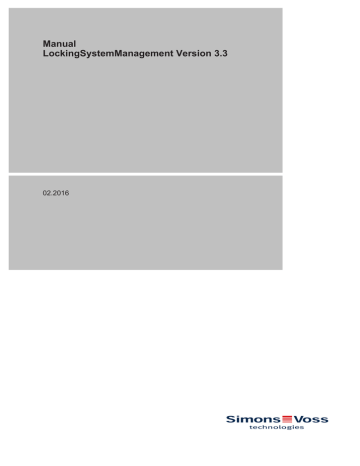- No category

advertisement

SimonsVoss 7 | Glossary & abbreviations 123 / 124
Manual
LockingSystemManagement Version 3.3
7 Glossary & abbreviations
Individual terms are explained in more detail below. The explanations are easy to understand, but may not contain all details.
Term Abbreviation Explanation
Advantage
Database Server
CSV file
DoorMonitoring
Freeze mode
Protocol generation
G1
Protocol generation
G2
Lightweight
Directory Access
Protocol
Locking Data Base
Software
Lock ID
Local Operating
Network
Locking System
Management
ADS server
DM
G1
G2
LDAP
Essential server service required to operate LSM Business and
Professional.
Standard file format for importing and exporting data, such as employee lists and locking systems.
Option for locking components which reports key door status properties, such as 'door closed' and 'double locked', to the LSM software.
When batteries reach a critical level, locking devices switch to freeze mode to allow the door to be opened one more time.
First protocol generation allowing locking devices and ID media to communicate.
Second protocol generation, which adds a number of convenience functions.
Network protocol to access and change information. LDAP can be used to upload employee data directly into the LSM software, for example.
LDB
LID
The preceding version of the LSM software.
Identifies the locking device within the locking system. (Can be compared to a car registration)
LON network
Local Operating Network (LON) is an older standard, which is/was mainly used for building automation.
LSM
Current software allowing flexible management of SimonsVoss locking components.
SimonsVoss 7 | Glossary & abbreviations 124 / 124
Manual
LockingSystemManagement Version 3.3
Term
Matrix
MIFARE
Personal Digital
Assistant
Physical Hardware
Identifier
Profile cylinder
Router
(CentralNode)
Transponder ID
Virtual network
Access control
Abbreviation Explanation
PDA
PHI
PC
TID
VN
AC
The matrix offers a clearly arranged view, showing which particular ID media are entitled to use specific locking devices.
MIFARE is a world standard for one of the most widely used card systems. (Locking device is activated with 'passive cards')
Small computer roughly the size of a smartphone. A PDA can be used as a portable device to programme active G1 locking components.
The PHI number is imprinted on
SimonsVoss components and stored in its internal memory. This number is fixed and cannot be changed.
A profile cylinder is the most widely used variety of security lock and a type of locking cylinder.
Special routers are used to address suitably equipped locking devices over the network.
Identifies the transponder within the locking system. (Can be compared to a car registration)
A 'virtual network' can be used to enjoy a variety of advantages offered by networks without special routers.
SimonsVoss components with an
AC function log all accesses (or
'bookings') in the locking system.
advertisement
* Your assessment is very important for improving the workof artificial intelligence, which forms the content of this project
Related manuals
advertisement
Table of contents
- 4 1 General information
- 4 1.1 Legal notes
- 4 1.2 Safety instructions
- 5 1.3 Minimum system requirements
- 6 1.4 Information on the manual
- 8 2 Installation
- 8 2.1 Software
- 8 2.1.1 LSM Basic
- 8 2.1.2 LSM Business
- 16 2.1.3 Register LSM
- 18 2.2 Programming devices
- 18 2.2.1 Install drivers for the programming devices
- 18 2.2.2 Identify programming devices and use properly
- 20 2.2.3 Programming distance
- 20 2.2.4 Check connection
- 21 3 First steps for a new installation
- 21 3.1 Recommended approach to handling passwords
- 21 3.2 Create database (BASIC)
- 22 3.3 Add locking system
- 25 3.3.1 Overview of protocol generations
- 26 3.3.2 G1 locking system
- 26 3.3.3 G2 locking system
- 26 3.3.4 Mixed G2 + G1 system
- 27 3.3.5 Overlay mode
- 28 4 User interface
- 29 4.1 User interface: Menu bar
- 29 4.1.1 File
- 29 4.1.2 Database
- 30 4.1.3 View
- 38 4.1.4 Installation wizards
- 38 4.1.5 Edit
- 83 4.1.6 Reports
- 89 4.1.7 Programming
- 92 4.1.8 Network
- 93 4.1.9 Options
- 98 4.1.10Windows
- 98 4.1.11Help
- 99 4.2 User interface: Menu ribbon
- 100 4.3 User interface: Locking system
- 100 4.4 User interface: Groups and areas
- 101 4.5 User interface: Matrix
- 104 5 Background knowledge on LSM
- 104 5.1 Group authorisations
- 104 5.1.1 Group reserves (G1 only)
- 104 5.1.2 Inheritance
- 105 5.2 Authorisations in the G2 protocol
- 105 5.3 Time zone plans
- 106 5.4 Common locking level
- 108 6 Basic functions
- 108 6.1 Add new locking system
- 108 6.2 Add new transponder group
- 108 6.3 Add new transponder
- 109 6.4 Assign transponder to a transponder group at later point in time
- 109 6.5 Add new area
- 109 6.6 Add new locking device
- 109 6.7 Assign locking device to an area
- 110 6.8 Issue/withdraw authorisation
- 110 6.9 Search matrix
- 111 6.10 Execute group actions
- 112 6.11 Programme transponder
- 112 6.12 Programme locking device
- 112 6.13 Set time zone plan
- 114 6.14 Resetting components
- 114 6.15 Replace defective locking device
- 115 6.16 Replace defective, lost or stolen transponders
- 116 6.17 Common locking level
- 116 6.17.1Add common locking level
- 117 6.17.2Link locking devices
- 118 6.17.3Link transponders
- 119 6.17.4Authorise transponders
- 119 6.18 Create fire service transponders
- 120 6.19 Install DoorMonitoring components
- 121 6.20 Programme using LSM Mobile
- 121 6.20.1With pocket PC/PDA
- 122 6.20.2With laptop, netbook or tablet PC
- 122 6.21 Reset storage mode in G1 locking devices
- 123 7 Glossary & abbreviations